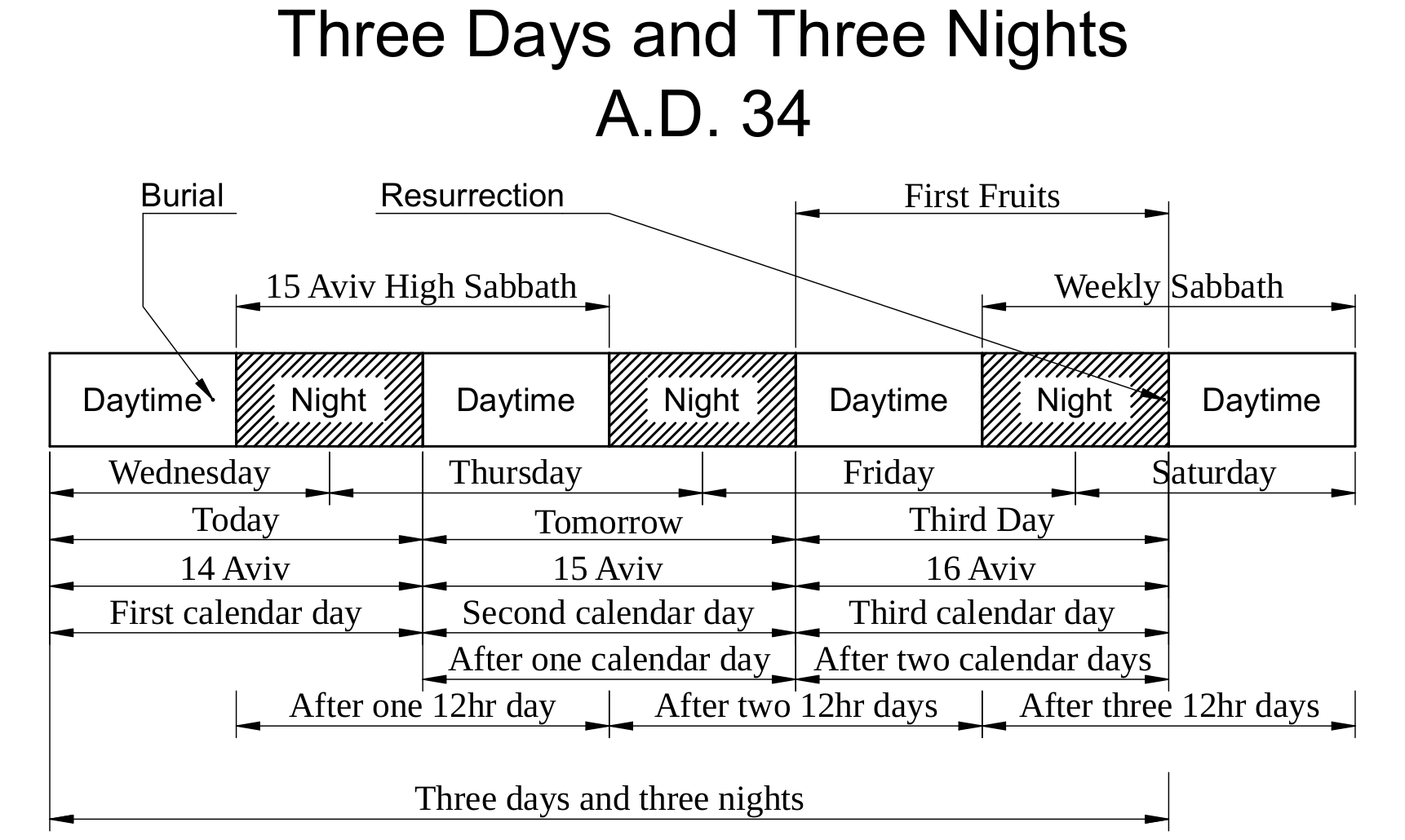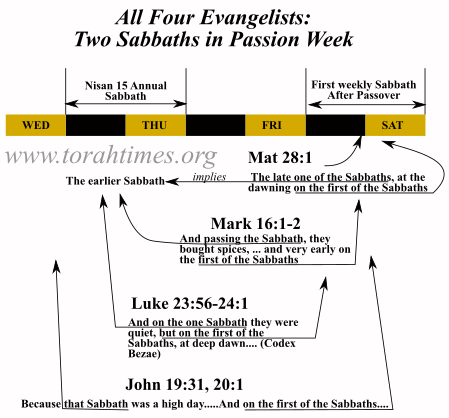First of the Sabbaths: The Four Gospels Agree
First of the Sabbaths: The Four Gospels Agree
The Gospel of Matthew
Mattityahu (Matthew) 28:1 reads:
But the later of the Sabbaths, at the dawning into the first of the Sabbaths, Miryam HaMagdalit and the other Miryam came to look at the tomb.
In 34 A.D., the Passover Sabbath fell on the Thursday (from Wednesday evening). The later of the two Sabbaths that week fell two days afterwards, on the Saturday (from Friday evening). This Sabbath is the first of the seven Sabbaths we are commanded to count until Shavuot (Pentecost). It was before dawn on this first of the (seven) Sabbaths when Yeshua was raised from death by the Father.
In the original Greek, the verse reads as follows.
Ὀψὲ δὲ σαββάτων, τῇ ἐπιφωσκούσῃ εἰς μίαν σαββάτων ἦλθεν Μαριὰμ ἡ Μαγδαληνὴ καὶ ἡ ἄλλη Μαρία θεωρῆσαι τὸν τάφον.
- Ὀψὲ δὲ σαββάτων
- Now the later of the Sabbaths.
- εἰς μίαν σαββάτων
- into the first of the Sabbaths.
My drawing (figure 1) shows the three days and three nights of Yeshua’s death and resurrection, and graphically details how he fulfilled the multiple prophecies concerning his death and resurrection. (On the third day, after three days, three days and three nights, the first fruits, and so on.)

Figure 1: Three Days and Three Nights Diagrammed.
The Gospel of Mark
We find the following wording in Mark 16:1–2:
And when the Shabbat [Passover Shabbat, Thursday 15 Aviv] was past [i.e., Friday 16 Aviv], Miryam HaMagdalit, and Miryam the mother of Ya’aqov, and Shelomit, bought spices, that they might come and anoint him.
And very early on the first of the Shabbats [the dawning of Saturday 17 Aviv], they arrived at the tomb at the rising of the sun.
The original Greek of Mark 16:1–2 is shown below.
Καὶ διαγενομένου τοῦ σαββάτου Μαρία ἡ Μαγδαληνὴ καὶ Μαρία ἡ Ἰακώβου καὶ Σαλώμη ἠγόρασαν ἀρώματα ἵνα ἐλθοῦσαι ἀλείψωσιν αὐτόν. καὶ λίαν πρωῒ τῇ μιᾷ τῶν σαββάτων ἔρχονται ἐπὶ τὸ μνημεῖον ἀνατείλαντος τοῦ ἡλίου.
The Gospel of Luke
Luke 24:1 should be combined with 23:56b, to read as per the following translation:
And on the one Shabbat they rested, but on the first of the Shabbats, at deep dawn they came upon the tomb, bringing the spices which they had prepared.
The Greek grammar and syntax requires the chapter break to occur at Luke 23:56b, and not at 24:1. The verse and chapter marks are not part of the original text. Translators typically ignore the grammar here because, not knowing the Law, they do not understand what Luke was saying (i.e., the correct reading according to normal Greek grammar does not make sense to them because of the lawless theology they have been taught).
The original Greek text of Luke 23:56b–24:1 is as follows.
καὶ τὸ μὲν σάββατον ἡσύχασαν [κατὰ τὴν ἐντολήν — not in Codex Bezae, one of the oldest manuscripts we have!], τῇ δὲ μιᾷ τῶν σαββάτων ὄρθρου βαθέως ἐπὶ τὸ μνῆμα ἦλθον φέρουσαι ἃ ἡτοίμασαν ἀρώματα.
- The phrase, “according to the commandment,” (κατὰ τὴν ἐντολήν) was a later scribal addition meant to draw the reader’s interpretation towards the weekly Sabbath.
- Notes on the Greek:
- καὶ τὸ μὲν σάββατον
- and on the one Sabbath
- τῇ δὲ μιᾷ τῶν σαββάτων
- but on the first of the Sabbaths
- μὲν ... δὲ
- a syntactical structure which is translated into English like the following example: “on the one hand … but on the other”
The Gospel of John
The text of John 20:1 reads:
Now on the first of the Shabbats Miryam HaMagdalit came early, while it was still dark at the tomb, and saw the stone already taken away from the tomb.
The original Greek text reads:
Τῇ δὲ μιᾷ τῶν σαββάτων Μαρία ἡ Μαγδαληνὴ ἔρχεται πρωῒ σκοτίας ἔτι οὔσης εἰς τὸ μνημεῖον, καὶ βλέπει τὸν λίθον ἠρμένον ἐκ τοῦ μνημείου.
Earlier, in 19:31, John notes:
… because that Shabbat had been great …
Thus, by drawing attention to the high Sabbath of 15 Aviv, John implies, along with the other three evangelists, that the first of the seven Shabbats counted towards Shavuot that year was the second Sabbath that week.
Conclusion
All four Gospel writers agree that Yeshua’s resurrection occurred on the first of the Sabbaths (τῇ μιᾷ τῶν σαββάτων), and careful distinction is made between the Passover Sabbath of 15 Aviv, and the weekly Sabbath which occurred two days later. The image below from Torah Times Messianic Ministry summarises this important fact.
The lawless theologian’s insistence that μιᾷ τῶν σαββάτων means, “first day of the week,” cannot be justified when the plain, literal meaning of the words makes perfect sense in every context in which they appear. The phrase never occurs in any Scriptural context other than the context of the time of Passover. No other first century or earlier Greek text (Scriptural or secular) testifies to the Church’s false claims in this matter.

Figure 2: Two Sabbaths in Passion Week. Used with permission.
Download
For offline reading or printing, you may wish to download the PDF version of this snippet.